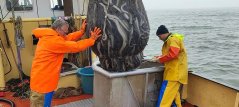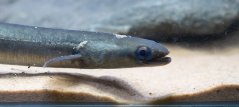
Longread
“Ultimately, we all benefit from a healthy eel population”
Research into the state of the eel population is essential to determine how to manage it. However, it is not easy to manage a fish species which is distributed from Iceland to North Africa and which also migrates to the ocean to reproduce.
Since the 1980s, the number of juvenile eels (glass eels) arriving annually on European and North African shores has declined by more than 90 percent. In 2007, the International Union for Conservation of Nature (IUCN) put the species on its Red List, in the 'critically endangered' category. Overfishing, water pollution and parasites, loss of habitat and obstacles such as pumping stations and hydropower plants on the migration route are cited as the causes of decline.
Much is being done to monitor and manage the status of the remaining population. Under the 2007 Eel Regulation, the European habitat is divided into Eel Management Units (EMUs). Every three years, member states must issue a forecast for each EMU on anthropogenic (human-caused) mortality and 'spawning stock biomass': a measure of silver eels migrating to the sea to reproduce.

How is that investigated? “For eel monitoring, fishing is carried out in certain areas using electrofishing gears, for example,” says Tessa van der Hammen, research associate at Wageningen Marine Research and project leader of the research which the Netherlands is legally obliged to carry out. “Numbers and length are recorded. We also do market sampling: checking the length, weight, age and sex of eels caught by fishermen.”
We also look at landings - the biomass of eels landed by fishermen and recorded by the Netherlands Enterprise Agency. In cooperation with Rijkswaterstaat and the Water Boards, eel mortality at pumping stations and hydropower plants is estimated. “All that data is put in different models to calculate a total biomass. But because the calculation requires quite a lot of assumptions, the calculation remains uncertain. The estimate of the spawning biomass is therefore subject to debate.”
European scale
In addition, there are sometimes local developments. “In the IJsselmeer, we have recently seen a substantial increase in eel biomass,” says Van der Hammen. “Larger and heavier animals, especially females. They are growing faster than before, possibly because the water is warmer due to climate change. But what happens in the IJsselmeer does not apply to the entire Dutch population. And what applies to the Dutch population does not apply to the total European population.”
They all eventually swim back to the Sargasso Sea, which means the eels always slip through your fingers
Because European eels sooner or later all migrate to the Sargasso Sea to reproduce, you need to study the stock on a European scale. “So, from Iceland to North Africa. The Dutch situation alone does not tell us a complete story.” In addition, Van der Hammen relies more on trends than estimates of absolute numbers of eel. “The best measure we have of the eel stock as a whole is the trend in the annual arrival of glass eels to European shores. And that is still only 5 to 10 percent of what it once was. In the early 1980s, there was a very sharp decline. Over the last 13 years, the stock has remained low, but there are no indications of further decline. We don’t really know how resilient the current stock is in the face of new threats. From a precautionary perspective, government agencies and public bodies are still obliged to take measures in case of uncertainties.”

With so many threats facing eels, the question is which ones have the most impact. Does water pollution weigh as heavily as the barriers on the migration route, and how much impact does fishing pressure have? “If only we knew,” says Hendrik-Jan Megens, research associate and Assistant Professor of Animal Breeding & Genomics at Wageningen University & Research. “Research being conducted in the university's Eel Project Group aims to fill in such blank spots on the map. It is plausible that there is not just one smoking gun, but rather a mix of factors, which in turn influence each other.”
So, there’s plenty to explore. To understand the status and reproductive capacity of the eel population, for example, it is important to have data on the sex and age of eels. “To determine the age, the annual rings are counted in the otoliths, the ear stones from the inner ear,” says Megens. “But doing that involves killing the eel. Eels don’t become sexually mature until they start migrating, so it’s also difficult to determine their sex. We are conducting research to make it easier to establish age and sex via so-called methylation patterns. For that, it is enough to take a fin clipping and then sequence the DNA.”
More females than males
Megens expects the first research results in six months' time. It will then be a while before the technology is sufficiently developed for use. “Now, the pieces of fin still need to be brought to the lab. However, in the somewhat further future, I think we will be able to do this with portable equipment on the boat. If we can determine age and sex, we can find out how long eels have been in the freshwater system, how fast they are growing, and build cohorts from that. And that will enable us to make better stock estimates.”
We often don't really know whether fish passages actually help the entry and exit of eels
A mysterious phenomenon that researchers are also keen to know more about is the changing ratio of males to females in the Dutch eel population. Van der Hammen: “At lower densities, and perhaps due to other unknown factors as well, the sex ratio of the population can change: more females than males emerge. In the IJsselmeer, you used to see mostly males, but now it’s almost only female eels. Scandinavian countries have always had predominantly females and southern Europe has traditionally had more males. There are also local differences: the further you go into inland waterways, the more females you find. Towards the coast, you tend to see males more often.”

A gender imbalance could affect the reproductive capacity of the species. Megens: “We want to know about that. And also what triggers gender development.” Is there an evolutionary advantage to having more females at lower densities? “Spawning takes place in the Sargasso Sea, so that’s where the benefit of certain reproductive strategies should eventually be cashed in. But that all happens out of our sight.”
Other research that is interesting to the Wageningen project group involves, for example, a Dynamic Energy Budget model that can provide insight into eel growth and reproduction. “Such a model shows how much energy an eel uses for growth, how much for fat storage, or for reproduction,” says Van der Hammen. “By adjusting variables like food supply, temperature or water quality, you can get predictions that tell you something about what the eel needs to spawn successfully.”

Releasing and transferring
Research into eels should also eventually help manage the population. “That’s not as easy with eels as with other animal species,” says Megens. “They all eventually swim back to the Sargasso Sea, which means they always slip through your fingers.”
Many different measures are being taken to protect the eel. European member states are drawing up eel management plans that include restricting fishing (with closed seasons in both salt water and freshwater), releasing glass eels, transferring silver eels at barriers on the migratory route, building fish passages in locks and pumping stations.
In the IJsselmeer, you used to see mostly males, but now it’s almost only female eels
“We will need to do further investigations to determine the effectiveness of all these measures,” says Van der Hammen. “We often don't really know whether fish passages actually help the entry and exit of eels. Research on fish mortality at pumping stations are often not specifically designed for eels. And we still have a lot of questions when it comes to restocking glass eels. Most glass eels are caught off the French coast and some of them are released into the freshwater of other countries, including the Netherlands. A key question is whether eels moved in this way have a better chance of maturing than if they had been able to swim up the French rivers on their own. And also whether they will still find their way back to the Sargasso Sea once they become silver eels.”

Wageningen University & Research plays an advisory role in determining which measures are needed. Van der Hammen: “We provide data, but it is up to government agencies and public bodies to make decisions. As a precautionary measure, the European ICES Working Group on Eels has been recommending a stop to eel fishing for years. The European Union and national governments must weigh such advice against the short and long-term interests of fishermen.” That is not easy to do. “In recent years, we have seen no further decline in glass eel arrivals. Nor is it clear at what size the eel stock is still healthy, and how resilient it is at its current size. What we do know is that the stock is much lower than before.”
Economic interests not only include the fishing industry, but also eel aquaculture.
Eel farmers hope that researchers will succeed in understanding the reproductive cycle of the eel so that eels can be bred from egg to adult. Although different
stakeholders will have different insights into how the eel population is doing,
Van der Hammen wants parties to communicate more and better. “And that includes
scientists. We recently did a project in which data from Wageningen Marine
Research and data from fishermen were studied together. This will allow us to
discuss eel management and how eel stocks are calculated. And create greater
understanding of each other's insights. Ultimately, we all benefit from a
healthy eel population.”